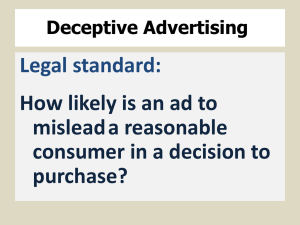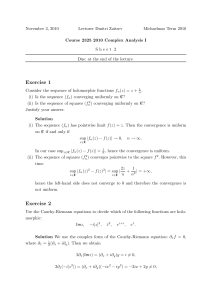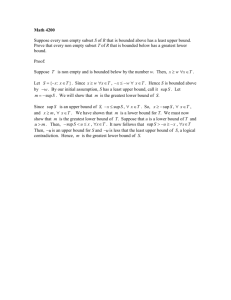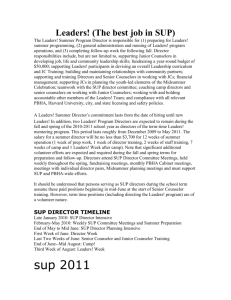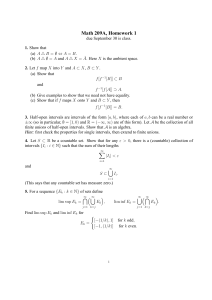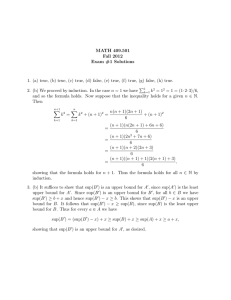MATH 409.200/501 Spring 2009 Exam #1 Solutions
advertisement
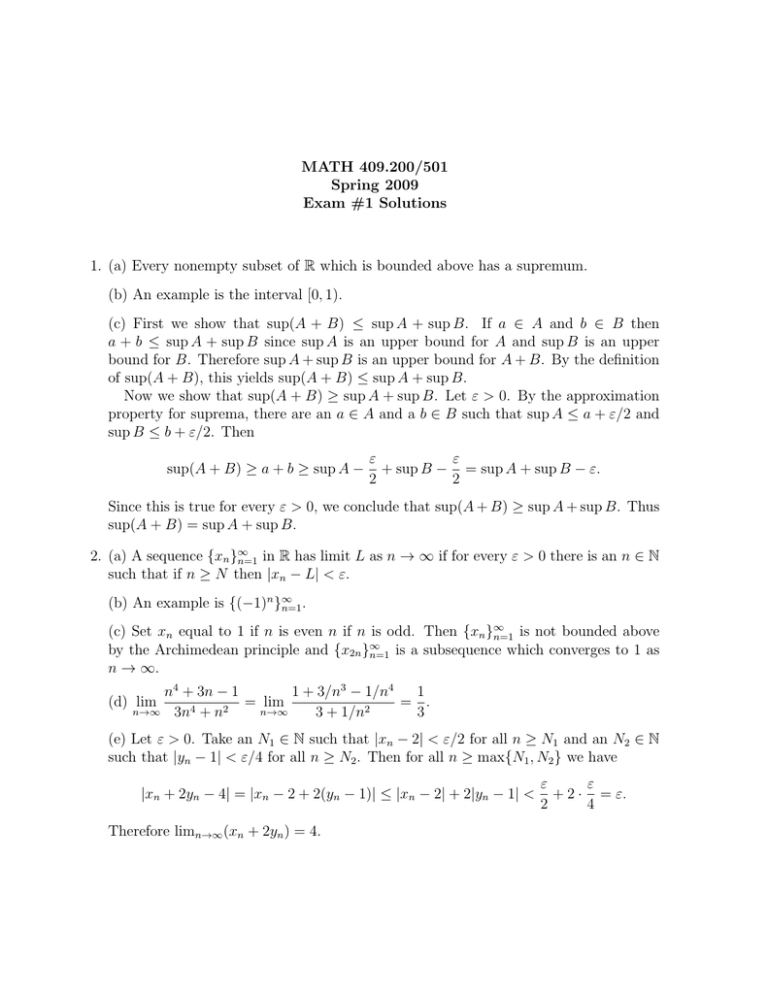
MATH 409.200/501
Spring 2009
Exam #1 Solutions
1. (a) Every nonempty subset of R which is bounded above has a supremum.
(b) An example is the interval [0, 1).
(c) First we show that sup(A + B) ≤ sup A + sup B. If a ∈ A and b ∈ B then
a + b ≤ sup A + sup B since sup A is an upper bound for A and sup B is an upper
bound for B. Therefore sup A + sup B is an upper bound for A + B. By the definition
of sup(A + B), this yields sup(A + B) ≤ sup A + sup B.
Now we show that sup(A + B) ≥ sup A + sup B. Let ε > 0. By the approximation
property for suprema, there are an a ∈ A and a b ∈ B such that sup A ≤ a + ε/2 and
sup B ≤ b + ε/2. Then
sup(A + B) ≥ a + b ≥ sup A −
ε
ε
+ sup B − = sup A + sup B − ε.
2
2
Since this is true for every ε > 0, we conclude that sup(A + B) ≥ sup A + sup B. Thus
sup(A + B) = sup A + sup B.
2. (a) A sequence {xn }∞
n=1 in R has limit L as n → ∞ if for every ε > 0 there is an n ∈ N
such that if n ≥ N then |xn − L| < ε.
(b) An example is {(−1)n }∞
n=1 .
(c) Set xn equal to 1 if n is even n if n is odd. Then {xn }∞
n=1 is not bounded above
∞
by the Archimedean principle and {x2n }n=1 is a subsequence which converges to 1 as
n → ∞.
n4 + 3n − 1
1 + 3/n3 − 1/n4
1
=
lim
=
.
n→∞ 3n4 + n2
n→∞
3 + 1/n2
3
(d) lim
(e) Let ε > 0. Take an N1 ∈ N such that |xn − 2| < ε/2 for all n ≥ N1 and an N2 ∈ N
such that |yn − 1| < ε/4 for all n ≥ N2 . Then for all n ≥ max{N1 , N2 } we have
|xn + 2yn − 4| = |xn − 2 + 2(yn − 1)| ≤ |xn − 2| + 2|yn − 1| <
Therefore limn→∞ (xn + 2yn ) = 4.
ε
ε
+ 2 · = ε.
2
4
3. (a) A set A is countable if there exists a bijective function f : N → A.
(b) Define a function f : N → A by f (n) = (m, m + n) for all n ∈ N. Then f is a
bijetcion, and so A is countable.
(c) For each m ∈ N write Am for the set of all open intervals in R of the
form (m, n)
S∞
for some integer n > m. Then Am is countable by part (b). Since B = m=1 Am and
a countable union of countable sets is countable, we conclude that B is countable.
4. (a) Define f : {0, 1} → {0} by f (0) = 0 and f (1) = 0. Set E = {0}. Then f −1 (f (E)) =
{0, 1} =
6 E.
(b) Set a = sup E. By nonemptiness we can pick an x1 ∈ E. By the approximation
property of suprema, there is an x2 ∈ E such that x1 < x2 ≤ a, and x2 6= a since a ∈
/E
by assumption. Again by the approximation property of suprema, there is an x3 ∈ E
such that x2 < x3 ≤ a, and x2 6= a since a ∈
/ E. Continue recursively applying the
approximation property of suprema to find elements xn ∈ E such that xn−1 < xn < a
for every n > 1. Now define f : N → E by f (n) = xn . Then f is an injection since the
sequence {xn }∞
n=1 is increasing.
5. (a) Every nonempty subset of N has a least element.
(b) We proceed by induction. The case n = 1 is obvious. Suppose that the assertion
is true for some n ∈ N. Then
n + 1 ≤ n + n = 2n < 2 · 2n = 2n+1 .
Thus n < 2n for all n ∈ N.
(c) Let ε > 0. Take an M > 0 such that |xn | ≤ M for all n ∈ N. Take an N ∈ N such
that N > M/ε. Then for all n ≥ N we have, using part (b),
xn = |xn | · 1 < M · 1 ≤ M · 1 < M · ε = ε.
2
2n
n
N
M
We conclude that xn /2n → 0 as n → ∞.



